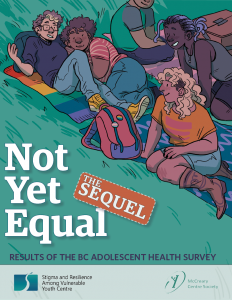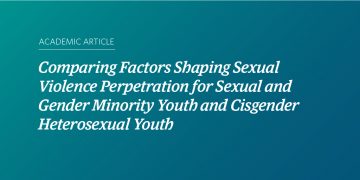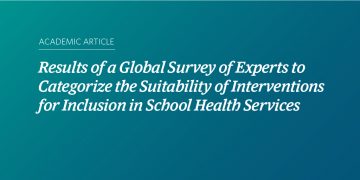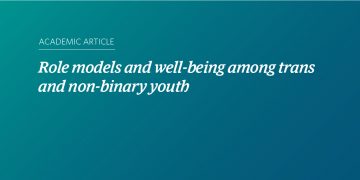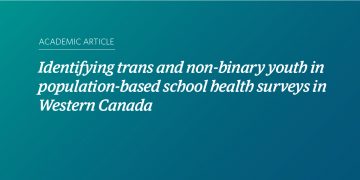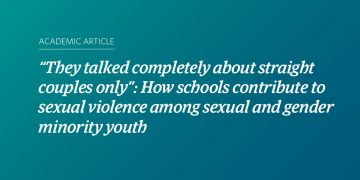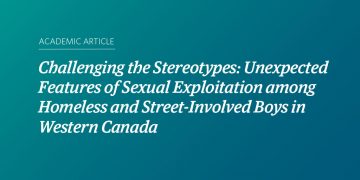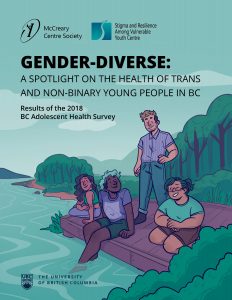Priority indicators for adolescent health measurement – recommendations from the Global Action for Measurement of Adolescent Health (GAMA) advisory group.
Abstract Purpose: This article describes the selection of priority indicators for adolescent (10–19 years) health measurement proposed by the Global Action for Measurement of Adolescent health advisory group and partners, building on previous work identifying 33 core measurement areas and mapping 413 indicators across these areas. Methods: The indicator selection process considered inputs from a broad range […]
Youth characteristics associated with sexual violence perpetration among transgender boys and girls, cisgender boys and girls, and non-binary youth.
Abstract Importance: Gender minority adults experience higher rates of sexual violence (SV) thancisgender adults. How this disparity extends to youths, including perpetration rates, is unknown. Objective: To compare rates of experience and perpetration of SV by gender identity andinvestigate characteristics associated with odds of perpetration within gender identity categories. Design, Setting, and Participants: This cross-sectional study […]
Not Yet Equal (the Sequel): Results of the BC Adolescent Health Survey
Not Yet Equal (the Sequel): Results of the BC Adolescent Health Survey provides a profile of the health LGBTQ youth in British Columbia (BC). The report is a collaboration between researchers at SARAVYC and the McCreary Centre Society and uses data from the 2018 BC Adolescent Health Survey (BC AHS), which is one of the […]
Comparing Factors Shaping Sexual Violence Perpetration for Sexual and Gender Minority Youth and Cisgender Heterosexual Youth
Abstract Sexual and gender minority (SGM) youth experience higher rates of sexual violence victimization than their cisgender heterosexual counterparts. Very little is known about how the minority status of SGM youth contextualizes their victimization and perpetration experiences. In one-on-one interviews with 39 SGM youth and 11 cisgender heterosexuals (non-SGM) youth, we compared the contextual factors […]
Results of a Global Survey of Experts to Categorize the Suitability of Interventions for Inclusion in School Health Services
Abstract Purpose: This global survey of experts assessed the suitability of different health-related interventions for inclusion in school health services (SHSs) to inform development of the World Health Organization global guideline on SHSs. Methods: A review of 138 global World Health Organization publications identified 406 health service interventions for 5- to 19-year-old individuals. These were consolidated, pretested, […]
Role models and well-being among trans and non-binary youth
Abstract Background It is important for young people to see themselves represented in stories, on television and in different job opportunities, so they can have an awareness of what is possible. While we often hear the words “representation matters,” research on how representation affects health outcomes of trans and non-binary (TNB) youth is lacking. In […]
Identifying trans and non-binary youth in population-based school health surveys in Western Canada
Abstract Background Most research about gender-diverse adolescents is with clinical samples, skewing population estimates of health and risk. With trans youth estimated at around 0.5% of the population and no reliable measures, school health surveys have not asked gender diversity items. In 2018, the British Columbia Adolescent Health Survey (BCAHS) in Canada trialled measures to […]
“They talked completely about straight couples only”: How schools contribute to sexual violence among sexual and gender minority youth
This study examined contextual factors shaping sexual violence victimisation and perpetration among sexual and gender minority youth, with school playing a key role. Based on qualitative data from semi-structured interviews with 50 young people aged 14–26 years who self-reported sexual violence perpetration in the Growing Up with Media survey, the analysis demonstrates how schooling’s ‘hidden curriculum’ leaves sexual and gender minority youth ill-equipped to navigate the world of sexuality.
Challenging the Stereotypes: Unexpected Features of Sexual Exploitation among Homeless and Street-Involved Boys in Western Canada
Research about the sexual exploitation of homeless and street-involved boys is limited and often combined with that of girls. As aggregation can distort unique issues among genders which are exploited, this study provides information about the context of exploitation for homeless boys.
